
MAY CONTAIN NUTS

Search Shorpy
SHORPY ART

Framed or unframed, desk size to sofa size, printed by us in Arizona and Alabama since 2007. Explore now.
Join and Share
Ad-Free Shorpy
Shorpy is funded by you. Patreon contributors get an ad-free experience.
Learn more.

Recent comments
- Side Winder
- Air Quality?
- Sojourner Truth riot
- None were so blind(ed)
- The less famous sister
- Good ol' days?
- Rise and Fall
- Goo Goo Ga Joob
- Ticket Retention
- Not the only one
- Vagaries of War
- Killed by Amtrak
- Back to the Future
- Wanted --
- If you can't stand the light
- Centralized Traffic Control, I believe
- What's really happening
- Heckuva remote control!
- Sometimes — Things Go Bump!
- I SEE THE LIGHT
- Union Switch and Signal Company
- Get That Light Out Of My Eyes
- Eggs. Eggs. Eggs. The Egg Man is Here!
- Foreboding caption
- Famous Hollywood faces
- Not just S&P
- re: Those things in the jar
- Up In Smoke
- Medical Smoking
- Quick fix
Member Photos
The Shorpy
Print Emporium
Print Emporium
Search Shorpy
Search results -- 30 results per page
- Waco: 1939
- ... sitting on bench on street, Waco, Texas." 35mm negative by Russell Lee for the Farm Security Administration. View full size.
(The Gallery, ... Posted by Dave - 05/05/2008 - 4:21pm -
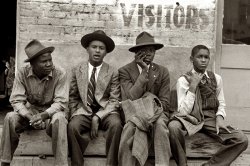
- Cheek to Cheek: 1940
- ... buffet supper and party. Eufaula, Oklahoma." Photo by Russell Lee for the Farm Security Admin. View full size.
Heaven, he's in ... Posted by Dave - 07/27/2018 - 11:12am -
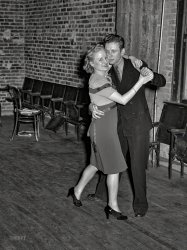
- Vagabonds: 1939
- ... his home was he said, 'It's all over.'" 35mm negative by Russell Lee. View full size.
Hard Times Indeed Poor man looks shell-shocked. ... Posted by Dave - 03/01/2012 - 10:33am -
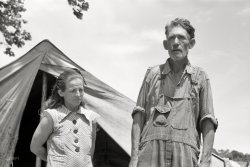
- Pee-Wee Playhouse: 1939
- ... family living in May Avenue camp, Oklahoma City." Photo by Russell Lee for the Farm Security Administration. View full size.
... the hill behind their shack.
(The Gallery, Kids, OKC, Russell Lee) ... Posted by Dave - 05/22/2018 - 1:14pm -
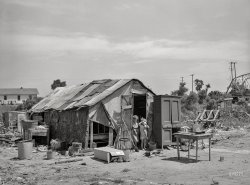
- The Desperate Hours: 1939
- ... Sharecropper's home." Medium format acetate negative by Russell Lee for the Farm Security Administration. View full size.
Osh Kosh ... Posted by Dave - 05/03/2018 - 8:50pm -
![The Desperate Hours: 1939 July 1939. "Detail of square dance in hills near McAlester, Pittsburg County, Oklahoma. Sharecropper's home." Medium format acetate negative by Russell Lee for the Farm Security Administration. View full size.
Osh Kosh B' GoshGet out your best overalls and cut a rug.
Sweat lodgeIn July in Oklahoma the temp is almost always in the triple digits and it seems like it would be stifling to be crammed into a sharecropper's tiny home with only a window slightly open for air and of course no a/c, with everybody dancing madly. I find the African American art on the wall of interest also.
[Tell us more about that art. - Dave]
(The Gallery, Russell Lee)](https://www.shorpy.com/files/images/SHORPY-8b22425a.thumbnail.jpg)
- A Spoonful of Sugar: 1938
- ... New Iberia, Louisiana." Medium format acetate negative by Russell Lee for the Farm Security Administration. View full size.
Unsafe Space ... Posted by Dave - 02/26/2018 - 9:17pm -
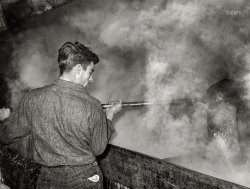
- Fight Club: 1941
- ... The scrappers last seen here . Acetate negative by Russell Lee for the Farm Security Administration. View full size.
One swole, ... Posted by Dave - 02/22/2019 - 12:32pm -
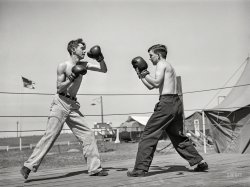
- Crank It: 1939
- ... Improvised chicken coop. Corn patch." Acetate negative by Russell Lee. View full size.
Buzzfeed Looks like the flies were healthy.
... Posted by Dave - 10/22/2019 - 12:05pm -
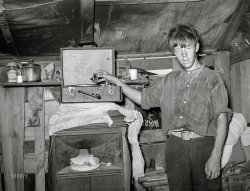
- Smooth Sailing: 1939
- ... of tenant purchase house. Hidalgo County, Texas." Photo by Russell Lee for the Farm Security Administration. View full size.
OCD Anyone? ... Posted by Dave - 03/28/2018 - 11:56am -
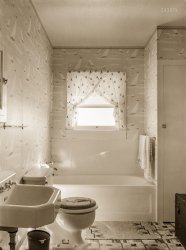
- Coop de Ville: 1939
- ... known as Oakland Heights, last seen here . Photo by Russell Lee for the Farm Security Administration. View full size.
Yuck! The ... Posted by Dave - 06/04/2018 - 11:22am -
![Coop de Ville: 1939 November 1939. "Old mansion in Comanche, Texas." Our second look at the pigeon roost otherwise known as Oakland Heights, last seen here. Photo by Russell Lee for the Farm Security Administration. View full size.
Yuck!The open window of that turret room probably has resulted in a massive pigeon-dropping mess.
Bird houseHas anyone cracked that house is for the birds?
But seriously, it's a fascinating house and I would like to know more about it -- when was it built and where can it be found on Google Maps? Comanche is a very small town but I can't find it.
[Possibly because it no longer exists. - Dave]
You can't get there from hereYou can't find this house because it was torn down in the 1950s. Oakland Heights stood on the western half of the block bounded by North Austin Street, West Neely Avenue, North Houston Street, and West Walcott Avenue. The modern-day address would be 107 West Walcott.
It was built shortly after 1887 by Dexter Walcott, for whom the street was named. Unfortunately, he didn't get to enjoy it much; he died suddenly and his widow had to superintend completion.
Much of the foundation is still there. If you look at the street view on Googlemaps, you can make out what I believe to be the right side foundation still there including the stairway going up on the side of the gazebo looking porch. Fascinating.
(Thank you Marchbanks for the address info).
Its replacementIs somewhat impressive in its own right. I looked on Google Maps and found the lot as described by Marchbanks. The sign out front says it's 105 West Walcott, and it's a shingle-sided, split level ranch, T-shaped in plan view. On the east side of the lot is what appears to be stonework from Oakland Heights' original foundation walls, backfilled with dirt and covered with grass, creating a terraced yard. Yeah, I'd live there.
Has a Mr. Hitchcock lived nearby?I can see where some ideas came from.
(The Gallery, Russell Lee)](https://www.shorpy.com/files/images/SHORPY-8b23404a1.thumbnail.jpg)
- Roof Watchers: 1938
- ... Louisiana." View full size. 35mm nitrate negative by Russell Lee for the Farm Security Administration. Library of Congress.
Watching ... Posted by Dave - 09/11/2011 - 10:46am -
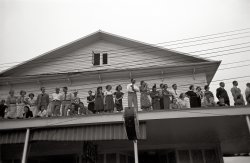
- Plucky: 1936
- ... acres, owner operated." Medium format nitrate negative by Russell Lee for the Farm Security Administration. View full size.
This could be ... Posted by Dave - 09/09/2011 - 2:27pm -
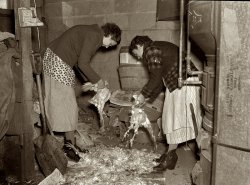
- Bumper Crop: 1941
- ... were getting ready for a bumper crop." Acetate negative by Russell Lee. View full size.
Still there Behind the circular bins on the ... Posted by Dave - 10/20/2018 - 3:42pm -
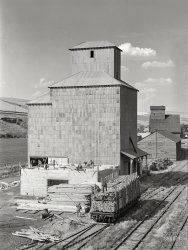
- Coffee Run: 1941
- ... Fourth of July at Vale, Oregon." 35mm nitrate negative by Russell Lee for the FSA. View full size.
Hair These kids' haircuts match the ... Posted by Dave - 07/06/2014 - 10:58am -
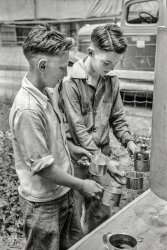
- Pulling Together: 1941
- ... July celebration. Vale, Oregon." 35mm acetate negative by Russell Lee for the Farm Security Administration. View full size.
Celebration ... Posted by Dave - 09/24/2020 - 11:21am -
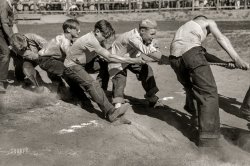
- Tahlequah Revival: 1939
- ... Oklahoma." View full size. 35mm nitrate negative by Russell Lee for the Farm Security Administration.
Wow, a National (probably) ... under $40.
(The Gallery, Music, Rural America, Russell Lee) ... Posted by Dave - 01/01/2009 - 10:34am -
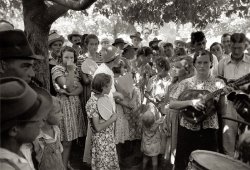
- Flight Command: 1941
- ... Southside, Chicago, Illinois." Medium format negative by Russell Lee for the Farm Security Administration. View full size.
Famous ... Posted by Dave - 09/20/2018 - 11:30am -
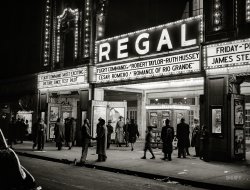
- Check Coolant: 1939
- ... friends in that town." Medium format acetate negative by Russell Lee for the Farm Security Administration. View full size.
The Rest of ... Posted by Dave - 10/22/2018 - 1:23pm -
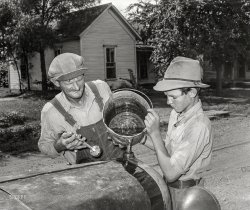
- South Side Cartman: 1941
- ... are common on South Side of Chicago." 35mm negative by Russell Lee for the Farm Security Administration. View full size.
(The Gallery, ... Posted by Dave - 09/09/2011 - 7:11pm -
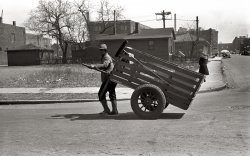
- OK City: 1939
- ... terminal in Oklahoma City." 35mm nitrate negative by Russell Lee, Farm Security Administration. View full size.
(The Gallery, Kids, ... Posted by Dave - 05/04/2018 - 11:33am -
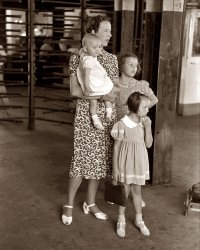
- The Three Degrees: 1940
- ... County, Arizona. Chandler Unit." Medium format negative by Russell Lee for the Farm Security Administration. View full size.
Pride and ... Posted by Dave - 07/25/2018 - 4:56pm -
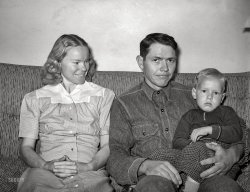
- Studious Schmidt: 1940
- ... Tulare County, California." Medium format negative by Russell Lee for the Farm Security Administration. View full size.
The Road to ... Posted by Dave - 08/29/2018 - 10:06pm -
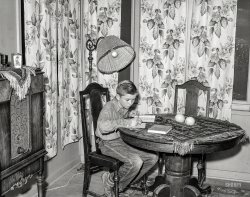
- Company Store: 1940
- ... mercantile company, the hospital and the hotel." Photo by Russell Lee for the Farm Security Administration. View full size.
The winner is ... Posted by Dave - 08/10/2018 - 12:23pm -
![Company Store: 1940 Spring 1940. "Store in Bisbee, Arizona. Phelps-Dodge practically owns this town: the copper mines, the principal mercantile company, the hospital and the hotel." Photo by Russell Lee for the Farm Security Administration. View full size.
The winner is ... ?I remember visiting this town in the mid-'70s and thinking how picturesque it looked. Within the space of a few years, however, things grew ugly. As copper prices dropped, Phelps Dodge began cutting its work force, resulting in a harsh, violence-filled strike. The town was literally torn apart by the situation, and many lives affected. At the end, the Company declared it was getting out of the copper business in Arizona, and closed the mine, leaving the town with no viable employment. I remember seeing the news stories at the time - a picture of a now-unemployed miner holding a sign -- "WE WON!" I'm glad the town has had a resurgence of tourism and artist colony.
[The Bisbee mines closed in 1974. The strike you're thinking of was in 1983, 170 miles away at the Phelps-Dodge open pit in Morenci, which is still in operation. Also, probably not "literally" torn apart, unless there was an earthquake or tornado! - Dave]
Bisbee Big BoxThe Streamline Moderne store (designed by Del Webb in 1939) still stands as a sort of shopping and dining arcade, but the giant building behind it is gone. What was it?
Big Box StoryThe big box building was a warehouse for the Phelps Dodge Mercantile. It was built prior to 1917, as it can be seen in photographs from the 1917 I.W.W. strike and subsequent Bisbee Deportation. It survived the 1938 fire that destroyed the previous Phelps Dodge Mercantile, which led to the construction of this new Streamline Moderne building. It was razed sometime between 1951 and 1960 and became a parking lot. Many more photos and information of Bisbee can be found at the Bisbee Mining and Historical Museum website.
Yesterday's tomorrows todayThe current street view seen in the earlier comment shows why surviving Streamline Moderne buildings need to be painted white as designed. The earth tone craze doesn't suit them at all.
Subway Street?Think they ever had a subway there?
[The Subway is the drainage channel that goes under the street. Once you get to the store, Subway turns into Tombstone Canyon Road. - Dave]
Still ThereThis page has a recent shot of the Mercantile building. It looks less grand than the 1940 view, but it's still recognizable.
Public transportation warThe building at the end of the street has a "Greyhound" sign on its frontispiece. On the same building there is a board saying: "Next time, try the train and BE SAFE". A message signed by Southern Pacific.
Part of Phelps DodgeThe building behind the store in question was also part of Phelps Dodge at least according to the picture posted from the back, you can see the name on the building behind the Kodak lettering. Offices maybe?
[Um, that's not "the building behind the store." That IS the store. Both views are from the front. That's the same sign in both photos. - Dave]
(The Gallery, Mining, Russell Lee, Small Towns, Stores & Markets)](https://www.shorpy.com/files/images/SHORPY-8b24857a1_Bisbee_AZ.thumbnail.jpg)
- Homeless Cooking: 1939
- ... salt meat for dinner." Medium-format nitrate negative by Russell Lee. View full size.
Brand names Hershey's, Quaker Oats, Oxydol, ... Posted by Dave - 01/14/2013 - 9:58pm -
![Homeless Cooking: 1939 February 1939. "Kitchen table and stove of white migrant tent camp near Harlingen, Texas. Married daughter of migrant worker cutting salt meat for dinner." Medium-format nitrate negative by Russell Lee. View full size.
Brand namesHershey's, Quaker Oats, Oxydol, MJB, Arm & Hammer, all still around. The box next to the Arm & Hammer seems to be a box of Jefferson Island Salt.
cool clockWow! My eyes were caught by the clock in this photo. I have the same clock! I was given to me when my grand father passed away many years ago. It still works like a charm.
Glad timers have gotten smallerInteresting cooking timer...do have to wonder why it is sitting on top of the stove??
Kerosene Cooking and Cost Cutting ClockThe kerosene cook stove has seen better days. The glass tank on the left held the kerosene. You run across these tanks at antique shops. While people have restored old wood or gas cook stoves to complete a "period" kitchen, you don't see many kerosene stoves restored. These stoves are still manufactured for use where natural gas and propane are unavailable or too costly. The clock maker economized by flipping the two to serve as a seven.
[Not really. - tterrace]
Kaboom --The stove makes me nervous... kerosene/gasoline stoves were not exactly the last word in safety under the best of circumstances, but this rusty, battered specimen is a death-wish special.
Kerosene stovesI can remember two kerosene stoves from my distant childhood. The smell was... penetrating.
Clock InfoI am happy to see many comments about the clock. This is a standard and mass produced kitchen clock, or gingerbread clock, and it's made by the Ingraham clock Co. This model is the "Cayuga". It was made around 1915 (but was probably made for several years). It's interesting to note that the clock doesn't appear to be running, since the pendulum isn't blurred.
[This was illuminated by flash bulb; exposure would have been 1/60 second or less, fast enough to freeze any pendulum motion. - tterrace]
Ingraham, like many other companies, mixed and matched their pressed wood pieces to make different models. The side pieces from this clock are seen on several different models, as is the base. The glass design also differs by year, by model, or simply by the customer's preference. Door moulding can also be slightly different from time to time, and occasionally hands get broken/lost/swapped.
As for the comment about the 2 and the 7, that's not really accurate. If you look at the numerals, the two curves are different, and this is just the style of the font used. Several other fonts use the same shape for a 6 and a 9, etc. There's also no money to be saved in this particular case. It's a printed paper dial. I have seen better examples of cost-cutting on a clock dial, where the 2 in the 12 (on applied cast numerals) had a notch cut out for a rating assembly, and rather than make a "non-notched" 2 for the 2-o'clock numeral, they left the notch in it.
I've attached a photo of a nearly identical (minus the glass) Cayuga.
(The Gallery, Kitchens etc., Russell Lee)](https://www.shorpy.com/files/images/SHORPY_8b37241u.thumbnail.jpg)
- Fight Camp: 1941
- ... unit. Athena, Oregon." Medium format acetate negative by Russell Lee for the Farm Security Administration. View full size.
Graffiti ... Posted by Dave - 10/18/2018 - 7:29pm -
![Fight Camp: 1941 June 1941. "Transient workers. Boxing platform at FSA migratory farm labor camp mobile unit. Athena, Oregon." Medium format acetate negative by Russell Lee for the Farm Security Administration. View full size.
GraffitiWere the kids of the era tagging the timbers of the ring? The lines don't look natural.
And I thought tagging was a modern problem.
[The scribbles here seem to be in crayon. - Dave]
Crayons or spray paint it's still considered "tagging".
TaggingThe only tagging going on here is in the ring. As far as crayons or spray paint being used, it would be considered "tagging" only if the graffitist signed his work. Either a real name, street name, nickname, initials or personal logo, so you can mark your territory.
This is a simple case of a bored little boy (off to the left) with a Crayola and a Dream.
(The Gallery, Kids, Russell Lee, Sports)](https://www.shorpy.com/files/images/SHORPY-8c01832a.thumbnail.jpg)
- Sunflower Plantation: 1939
- ... Merigold, Mississippi." Medium format nitrate negative by Russell Lee. View full size.
The plot thickens. Looks like a scene of a ... Posted by Dave - 06/14/2018 - 6:08am -
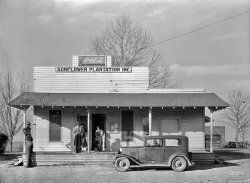
- Jolly Time: 1936
- ... Popcorn stand in Ames, Iowa." Medium format negative by Russell Lee for the Resettlement Administration. View full size.
Dunnage I ... Posted by Dave - 06/28/2018 - 9:36am -
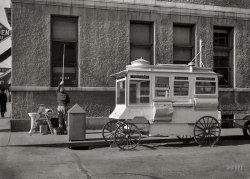
- Small Oil: 1939
- ... Oklahoma City, Oklahoma." Medium format negative by Russell Lee for the Farm Security Administration. View full size.
OSHA ... Posted by Dave - 06/02/2018 - 12:17pm -
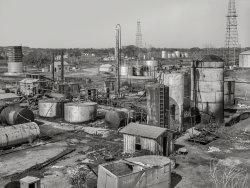
- Seedsto Day: 1939
- ... parked under gin shed. Mound Bayou, Mississippi." Photo by Russell Lee, Farm Security Administration. View full size.
The Presleys of ... Posted by Dave - 10/22/2013 - 12:42pm -
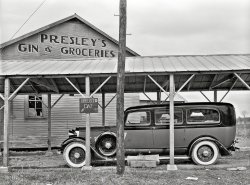
- Self-Contained: 1939
- ... Privy made of automobile body." Medium format negative by Russell Lee for the Farm Security Administration. View full size.
Kitten finds ... Posted by Dave - 05/23/2018 - 2:46pm -
![Self-Contained: 1939 March 1939. "Home of fisherman squatter on shores of Nueces Bay. Corpus Christi, Texas. Photographs show squatters and migrants in shanty town along Nueces Bay area. Tents, shelters constructed from old boats, tar paper, automobile licenses, boxes. Privy made of automobile body." Medium format negative by Russell Lee for the Farm Security Administration. View full size.
Kitten finds fantasy living arrangementThat cat on the doorstep must know that he will have fish and seafood aplenty as long as he sticks around with fishermen squatters and he is not planning to leave this location. How lucky can one cat get?
It was worse than we knowMy father (1907-1983) often said that I or my children could never imagine the hunger, squalor and hopelessness of the Great Depression.
Kitten!There has never ever been a building or a place around fishing that didn’t have a cat or two. And these people, though poor, at least kept the area around their shack swept and picked up.
[There's also a big dog. - Dave]
ForagingOne thing I remember during the depression is foraging for extra food. We'd pick dandelions to be had for greens. Not too bad, as I remember. My dad had no job til about 1939, so we lived a while with my grandmother, and later out west on my aunt and uncles ranch. At least we wern't relegated to a shack. I don't recall feeling deprived. Most people were in the same boat.
(The Gallery, Cats, Dogs, Russell Lee)](https://www.shorpy.com/files/images/SHORPY-8b21017a.thumbnail.jpg)























